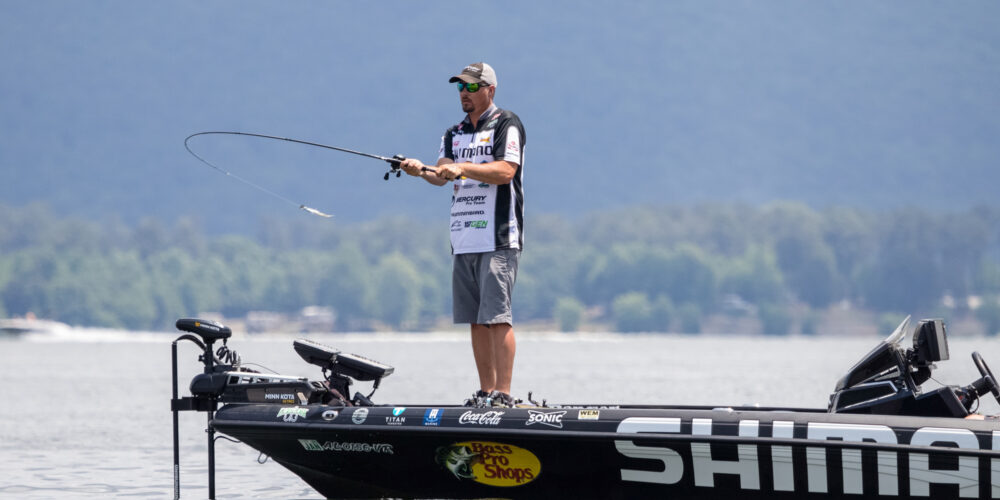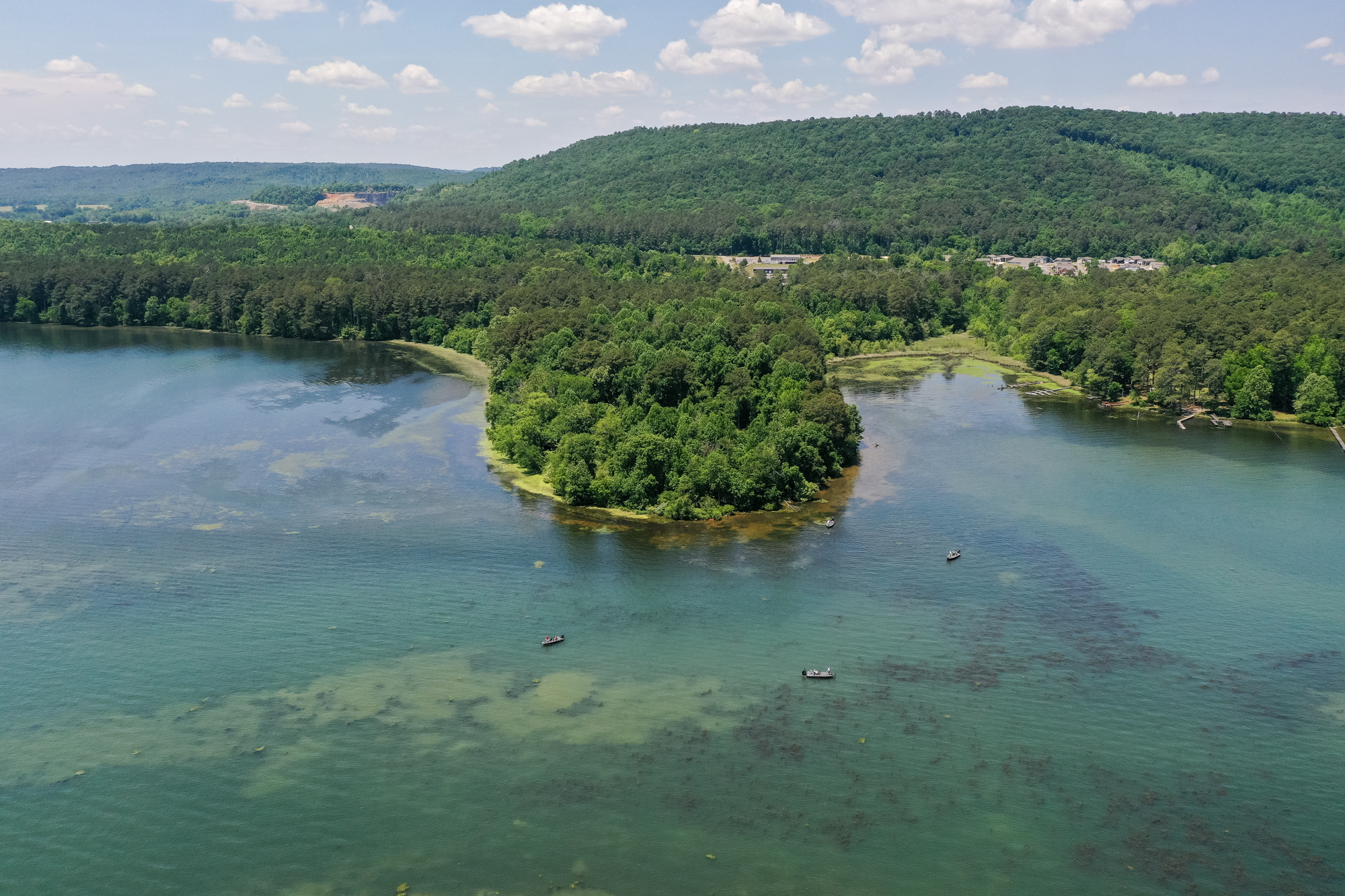ALEX DAVIS: Bass Pro Tour anglers are in for a treat at Guntersville (but bring some Band-Aids)

The Bass Pro Tour is coming to Lake Guntersville this week and I hope they bring plenty of Band-Aids for the “bass rash” they’ll have on their hands from handling so many fish. I’ve been guiding on Guntersville for 15 years now and I can honestly say, the lake is as healthy as I’ve ever seen it. It’s chock full of bass that are feeding back up after the spawn and they are chewing. Despite the immense amount of fishing pressure this pond gets, it still amazes me how aggressive the bass are day in and day out.
Rolling with the changes
A lot has changed on Guntersville over the last 5 to 10 years. The biggest change has been a drastic swap in the dominant vegetation from hydrilla and milfoil to eelgrass. Some odd strain of eelgrass found its way into the TVA system about five years ago, and it has spread like wildfire, pushing hydrilla and milfoil out of the way. Some claim it’s a form of eelgrass commonly used in aquariums that has somehow taken a foothold in our lakes. It grows about 2 to 4 feet high on flats and will grow down as deep as 12 to 13 feet.
Unlike eelgrasses in Florida, which have deep roots and holds well in the ground, this form of eelgrass is very shallow-rooted and therefore easily comes up out of the ground, floats to the surface and spreads like crazy.
When the eelgrass first started five years ago, it was splotchy and inconsistent. The verdict was still out as to whether bass used it or not. But five years later, the lake bottom is a carpet of this dark green stuff and there’s no doubt bass love it. I think one reason fishing has improved so drastically over the last few years is that the eelgrass has created so much more habitat. Bass have successful spawns because the fry survival rate is so high in the thick eelgrass.
In my opinion, the population of bass has doubled or even tripled since the eelgrass took over. This form of eelgrass tends to tolerate the cold, muddy waters of winter very well. It’s certainly a lot heartier than hydrilla and milfoil. Even though we get a lot of muddy water in the winter and spring, it still seems to flourish when hydrilla is dying.
This new vegetation does have a few drawbacks, though. The bad news is that when it gets uprooted from strong currents, prop wash and even big waves from wind, it floats and can be everywhere on the surface, making fishing extremely difficult. If a wind pushes a mass of floating eelgrass over your best area, it’ll make it completely unfishable. Lures simply can’t work through it efficiently. I guess that’s a double-edged sword: you may not be able to fish a good area for a couple of days, but neither can anyone else. So, in a way, these big floating masses of grass can literally protect a good area from fishing pressure for several days. Then when a wind comes in or switches directions and cleans the floating mass off, it’s game on for fish that haven’t seen a lure in a few days.

Deep ledges have dwindled
Another big change is the deeper ledges that used to dominate this time of year are not as potent as they used to be. Don’t get me wrong, there are still deep fish to be caught, but it’s not the same ledge-cranking game that it was 15 years ago.
I think the vast amounts of eelgrass have given bass a better alternative to spread out and not be so pressured. The TVA doesn’t seem to pull as much current during the day as it used to at Guntersville. The current gets generated more in the evenings and at night and I think that’s when those deep fish really feed the most. The light current during the day lets fish suspend more in the mid-column than they used to. Also, that type of current creates soft eddies along the river that really gather up some of the thickest mats over the best deep holes.
Finally, every deep spot has become a community hole and there are boats on them from daylight till dark. In my opinion, some of the biggest fish in Guntersville still live on the ledges, but I think they mostly feed at night in heavier current and are the hardest to fish for during the day because of the floating grass and constant local pressure.
Current conditions
The weekend before the event, we have prime conditions at Guntersville. The water temperature is 73 degrees, the water is fairly stable and clean with a visibility of about 3 feet. There’s going to be a load of bass caught during the Bass Pro Tour event. Most of the bass have spawned, but they’re putting their weight back on quickly and they look healthy. Even spotted bass are getting big and starting to raise a few eyebrows. There are plenty of 3-pound-plus spots being caught; on a guide trip the other day, we caught two spots in the 5-pound class.
The ways to catch bass right now are numerous and varied. Bass are on just about every kind of cover or structure available. Eelgrass flats, rip rap, bridges, docks and ledges. I predict the three primary players this week will be eelgrass flats, bream beds and fishing deep ledges.
Those fishing eelgrass flats will have to cover a lot of water and cull through a lot of fish, but 20-pound bags are certainly possible fishing that way. Bream beds have been growing by the day since the last full moon and there’s no doubt bream eaters will play. Finally, someone will crack the deep code to catch some big ones to get into the upper 20s.
There are no more secret deep spots in Guntersville anymore, and those deep fish are the smartest bass in the lake. But there are also new lures out there that those fish have not seen, and when you show “smart fish” a new lure, it can be pure magic. Anyone remember when Paul Elias lapped the field with an Alabama Rig in 2011? I do – it was an amazing display of what one angler can do on Guntersville when he has a lure no one else has.
Aside from that, guys who mix and match these three approaches have the best shot. Perhaps eelgrass in the morning, bream beds midday and then probing for a couple of bigs in the afternoon on deeper stuff.
A recent tournament with 250 boats took 30 pounds to win. If you brought in a respectable 17 pounds, it left you in 35th place. What will make this event so much fun for the Bass Pro Tour guys are the numbers of fish they’ll catch each day. They’ll have to cull through lots of fish to get to the 20-pound mark every day – my recent guide clients have experienced 75- to 100-fish days.
Like I said, better bring some Band-Aids.